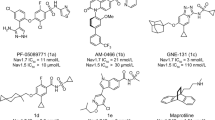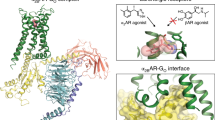Abstract
WE have found that the benzyl quaternary ammonium compounds (I, patents pending) have a novel and highly specific blocking action on the peripheral sympathetic nervous system, which resembles that following section of adrenergic nerves and differs from that produced by adrenolytics, ganglion-blocking agents and reserpine. 
This is a preview of subscription content, access via your institution
Access options
Subscribe to this journal
Receive 51 print issues and online access
$199.00 per year
only $3.90 per issue
Buy this article
- Purchase on Springer Link
- Instant access to full article PDF
Prices may be subject to local taxes which are calculated during checkout
Similar content being viewed by others
References
Hey, P., and Willey, G. L., Brit. J. Pharmacol., 9, 471 (1954).
Coupland, R. E., and Exley, K. A., Brit. J. Pharmacol., 12, 306 (1957).
Bain, W. A., and Fielden, R., Lancet, ii, 472 (1957).
Author information
Authors and Affiliations
Rights and permissions
About this article
Cite this article
BOURA, A., COPP, F. & GREEN, A. New Antiadrenergic Compounds. Nature 184, BA70–BA71 (1959). https://doi.org/10.1038/184070a0b
Issue Date:
DOI: https://doi.org/10.1038/184070a0b
This article is cited by
-
Effect of guanethidine desympathization on cardiac function in young rats
Bulletin of Experimental Biology and Medicine (1986)
-
Adrenergic Neurone-blocking Agents related to Choline 2,6-Xylyl Ether Bromide (TM 10), Bretylium and Guanethidine
Nature (1961)
-
Powerful Adrenergic Neurone-blocking Agents related to Choline 2,6-Xylyl Ether Bromide
Nature (1960)
Comments
By submitting a comment you agree to abide by our Terms and Community Guidelines. If you find something abusive or that does not comply with our terms or guidelines please flag it as inappropriate.



